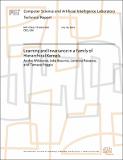| dc.contributor.advisor | Tomaso Poggio | |
| dc.contributor.author | Wibisono, Andre | en_US |
| dc.contributor.author | Bouvrie, Jake | en_US |
| dc.contributor.author | Rosasco, Lorenzo | en_US |
| dc.contributor.author | Poggio, Tomaso | en_US |
| dc.contributor.other | Center for Biological and Computational Learning (CBCL) | en_US |
| dc.date.accessioned | 2010-07-30T17:45:16Z | |
| dc.date.available | 2010-07-30T17:45:16Z | |
| dc.date.issued | 2010-07-30 | |
| dc.identifier.uri | http://hdl.handle.net/1721.1/57464 | |
| dc.description.abstract | Understanding invariance and discrimination properties of hierarchical models is arguably the key to understanding how and why such models, of which the the mammalian visual system is one instance, can lead to good generalization properties and reduce the sample complexity of a given learning task. In this paper we explore invariance to transformation and the role of layer-wise embeddings within an abstract framework of hierarchical kernels motivated by the visual cortex. Here a novel form of invariance is induced by propagating the effect of locally defined, invariant kernels throughout a hierarchy. We study this notion of invariance empirically. We then present an extension of the abstract hierarchical modeling framework to incorporate layer-wise embeddings, which we demonstrate can lead to improved generalization and scalable algorithms. Finally we analyze experimentally sample complexity properties as a function of architectural parameters. | en_US |
| dc.format.extent | 9 p. | en_US |
| dc.relation.ispartofseries | CBCL-290 | en_US |
| dc.relation.ispartofseries | MIT-CSAIL-TR-2010-035 | en_US |
| dc.subject | artificial intelligence | en_US |
| dc.title | Learning and Invariance in a Family of Hierarchical Kernels | en_US |
